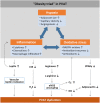The role of perivascular adipose tissue in obesity-induced vascular dysfunction
- PMID: 27761903
- PMCID: PMC5610151
- DOI: 10.1111/bph.13650
The role of perivascular adipose tissue in obesity-induced vascular dysfunction
Abstract
Under physiological conditions, perivascular adipose tissue (PVAT) attenuates agonist-induced vasoconstriction by releasing vasoactive molecules including hydrogen peroxide, angiotensin 1-7, adiponectin, methyl palmitate, hydrogen sulfide, NO and leptin. This anticontractile effect of PVAT is lost under conditions of obesity. The central mechanism underlying this PVAT dysfunction in obesity is likely to be an 'obesity triad' (consisting of PVAT hypoxia, inflammation and oxidative stress) that leads to the impairment of PVAT-derived vasoregulators. The production of hydrogen sulfide, NO and adiponectin by PVAT is reduced in obesity, whereas the vasodilator response to leptin is impaired (vascular leptin resistance). Strikingly, the vasodilator response to acetylcholine is reduced only in PVAT-containing, but not in PVAT-free thoracic aorta isolated from diet-induced obese mice, indicating a unique role for PVAT in obesity-induced vascular dysfunction. Furthermore, PVAT dysfunction has also been observed in small arteries isolated from the gluteal/visceral fat biopsy samples of obese individuals. Therefore, PVAT may represent a new therapeutic target for vascular complications in obesity. A number of approaches are currently being tested under experimental conditions. Potential therapeutic strategies improving PVAT function include body weight reduction, enhancing PVAT hydrogen sulfide release (e.g. rosiglitazone, atorvastatin and cannabinoid CB1 receptor agonists) and NO production (e.g. arginase inhibitors), inhibition of the renin-angiotensin-aldosterone system, inhibition of inflammation with melatonin or cytokine antagonists, activators of AMP-activated kinase (e.g. metformin, resveratrol and diosgenin) and adiponectin releasers or expression enhancers.
Linked articles: This article is part of a themed section on Molecular Mechanisms Regulating Perivascular Adipose Tissue - Potential Pharmacological Targets? To view the other articles in this section visit http://onlinelibrary.wiley.com/doi/10.1111/bph.v174.20/issuetoc.
© 2016 The Authors. British Journal of Pharmacology published by John Wiley & Sons Ltd on behalf of British Pharmacological Society.
Figures



Similar articles
-
Restoration of perivascular adipose tissue function in diet-induced obese mice without changing bodyweight.Br J Pharmacol. 2017 Oct;174(20):3443-3453. doi: 10.1111/bph.13703. Epub 2017 Jan 31. Br J Pharmacol. 2017. PMID: 28055105 Free PMC article.
-
Increased mitochondrial ROS generation mediates the loss of the anti-contractile effects of perivascular adipose tissue in high-fat diet obese mice.Br J Pharmacol. 2017 Oct;174(20):3527-3541. doi: 10.1111/bph.13687. Epub 2017 Jan 12. Br J Pharmacol. 2017. PMID: 27930804 Free PMC article.
-
Deletion of AMPKα1 attenuates the anticontractile effect of perivascular adipose tissue (PVAT) and reduces adiponectin release.Br J Pharmacol. 2017 Oct;174(20):3398-3410. doi: 10.1111/bph.13633. Epub 2016 Oct 23. Br J Pharmacol. 2017. PMID: 27668984 Free PMC article.
-
Pro-contractile effects of perivascular fat in health and disease.Br J Pharmacol. 2017 Oct;174(20):3482-3495. doi: 10.1111/bph.13767. Epub 2017 Apr 3. Br J Pharmacol. 2017. PMID: 28257140 Free PMC article. Review.
-
Perivascular adipose tissue as a regulator of vascular disease pathogenesis: identifying novel therapeutic targets.Br J Pharmacol. 2017 Oct;174(20):3411-3424. doi: 10.1111/bph.13666. Epub 2016 Dec 14. Br J Pharmacol. 2017. PMID: 27976387 Free PMC article. Review.
Cited by
-
The Weight of Obesity in Immunity from Influenza to COVID-19.Front Cell Infect Microbiol. 2021 Mar 17;11:638852. doi: 10.3389/fcimb.2021.638852. eCollection 2021. Front Cell Infect Microbiol. 2021. PMID: 33816341 Free PMC article. Review.
-
Sex-specific characterization of aortic function and inflammation in a new diet-induced mouse model of metabolic syndrome.FASEB J. 2025 Mar 15;39(5):e70413. doi: 10.1096/fj.202401871R. FASEB J. 2025. PMID: 40035569 Free PMC article.
-
Perivascular adipose tissue (PVAT) in atherosclerosis: a double-edged sword.Cardiovasc Diabetol. 2018 Oct 10;17(1):134. doi: 10.1186/s12933-018-0777-x. Cardiovasc Diabetol. 2018. PMID: 30305178 Free PMC article. Review.
-
NO, ROS, RAS, and PVAT: More Than a Soup of Letters.Front Physiol. 2021 Feb 10;12:640021. doi: 10.3389/fphys.2021.640021. eCollection 2021. Front Physiol. 2021. PMID: 33643076 Free PMC article. Review.
-
Expression of Melatonin Receptor 1 in Rat Mesenteric Artery and Perivascular Adipose Tissue and Vasoactive Action of Melatonin.Cell Mol Neurobiol. 2021 Oct;41(7):1589-1598. doi: 10.1007/s10571-020-00928-w. Epub 2020 Jul 30. Cell Mol Neurobiol. 2021. PMID: 32734322 Free PMC article.
References
-
- Agabiti‐Rosei C, De Ciuceis C, Rossini C, Porteri E, Rodella LF, Withers SB et al. (2014). Anticontractile activity of perivascular fat in obese mice and the effect of long‐term treatment with melatonin. J Hypertens 32: 1264–1274. - PubMed
-
- Aghamohammadzadeh R, Greenstein AS, Yadav R, Jeziorska M, Hama S, Soltani F et al. (2013). Effects of bariatric surgery on human small artery function: evidence for reduction in perivascular adipocyte inflammation, and the restoration of normal anticontractile activity despite persistent obesity. J Am Coll Cardiol 62: 128–135. - PMC - PubMed
-
- Ahmed SR, Johansson BL, Karlsson MG, Souza DS, Dashwood MR, Loesch A (2004). Human saphenous vein and coronary bypass surgery: ultrastructural aspects of conventional and “no‐touch” vein graft preparations. Histol Histopathol 19: 421–433. - PubMed
Publication types
MeSH terms
LinkOut - more resources
Full Text Sources
Other Literature Sources
Medical

